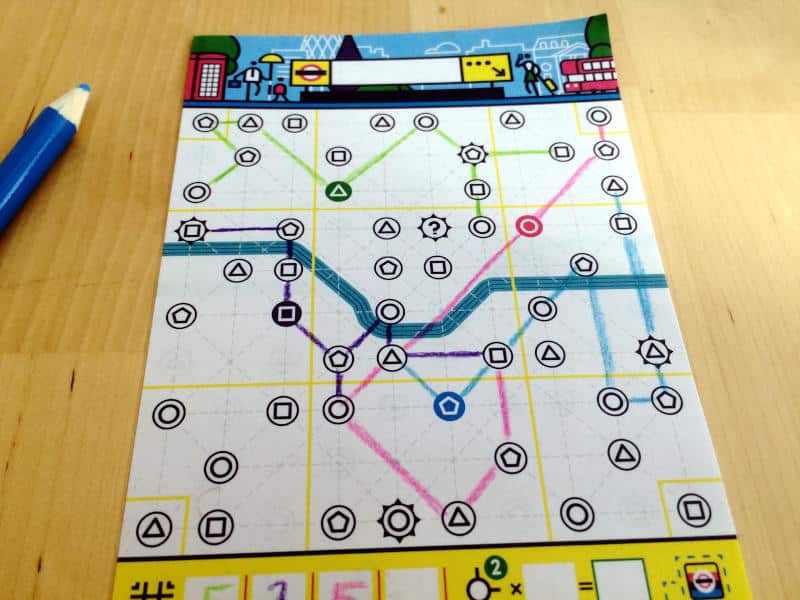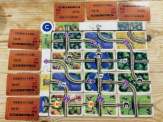| Release Date: 2022 | Players: 1-4 |
| Designer: Matthew Dunstan | Length: 15-45 minutes |
| Artist: Maxime Morin | Age: 8+ |
| Publisher: Blue Orange Games | Complexity: 1.5 / 5 |
| Plastic (by weight): <1% | Air (by volume): <10% |
London’s ageing underground network is creaking and groaning. It can no longer keep up with the exponentially increasing demand of daily commuters and rising tourist numbers to the UK’s capital. It’s time to scrap it all and start anew and Transport for London has hired you to redesign everything. It won’t be easy to optimize the interchanges for a better flow, provide stops to as many tourist sites as possible and take advantage of the tunnels passing underneath the Thames. The first station has been built and now it’s up to you to create the Next Station: London by Matthew Dunstan from Blue Orange Games.
All right. Maybe the introduction is a bit grand. At the end of the day, Next Station: London is just another something-and-write game. It’s in line with all the other games in the genre that are rolling into the hobby all the time. Yet, the designer Matthew Dunstan has achieved something with this particular game that is a bit of a showstopper. In my view, Next Station: London is on track to be one of the best games in this overcrowded genre – but let me stop with my escalating puns and explain why I have come to this conclusion.
First Station: Step-Free Access
Any game that wants to stand out from the rest must have rules that are easy to learn. The simpler the rules, the quicker you get to play. If a game can create a lot of depth from only a handful of rules, you know you have something that will keep you entertained for quite some time. Next Station: London‘s rules fit on about two and a half pages that are roughly A5 in size. So, there really isn’t a lot to learn.
Another reason why Next Station: London is so easy to learn is that it is so very visual. As you take turns and draw your lines, you can see what’s happening right away in front of you. You can immediately spot when you’re possibly painting yourself into a corner. You can easily work out when you should mind the gap and leave room for other lines to get through.
Being visual isn’t unique to Next Station: London, of course. All something-and-write games are visual in nature. However, drawing on a grid of dotted lines to create a tube map is so much more immersive than crossing boxes on a sheet, which feels more like working on a spreadsheet than playing a game. Creating a new network of Underground lines is so much easier to understand and links so much more closely with the rules than other games in the genre achieve. Even if you’ve never been on a London tube train or never visited London, you will probably be familiar with the famous map. At the very least, you will have come across underground or even train network maps from other cities. So playing Next Station: London should feel really intuitive to a lot of people.

Next Station: Underground
Despite the light rules overhead and intuitiveness, there is still a lot of depth in the game. That depth clearly doesn’t come from the rules, but from the decisions players make on their turn. Extending your tube line in one direction over another can have a huge impact later. What seemed like an innocent choice at the time, could turn out to be the worst thing you have done all game. The game actually tries to pull you in different directions all at the same time. You can’t do it all, so you have to choose what to focus on. At the same time, you really only ever have a tiny handful of options. You’re never sitting there for ages trying to figure out what to do.
There is also a fair bit of randomness in Next Station: London. That means players don’t have to worry too much about making the wrong choice. It takes the pressure off a little and reduces the chances of someone freezing with analysis paralysis. At the same time, the randomness is not completely random. There is a fixed deck of cards that decides which station you connect to next. So you know what to expect and you can work out what’s left. However, you never know what card will come up next or whether you will get through the whole deck. It’s a really good balance to introduce surprises, without making it completely random.
Another plus point, at least for some people, is that the game has no player interaction. There is no blocking or stealing or anything. Everyone just happily draws their lines on their own sheet and marvels at the beautiful map they’re creating.
Last Station: Overground
The last thing that makes Next Station: London stand out for me is the quality of the components. The box has a magnetic lid. I know, it’s a silly little thing, but it’s so very satisfying. The cards have a good thickness and should easily endure many, many plays. The pencils come in a little paper envelope and are quite long. Eventually, you will have to replace them, but it’s going to be a while before that happens. Similarly, the pad of player sheets will eventually run out. Every sheet is double-sided though, so you get two plays out of each one. You can always either photocopy them or print off new ones from the publisher’s website.
Additionally, there is basically no plastic, except maybe a small amount of spot UV varnish. I think that’s great to see and a real plus point. It’s something that we, as consumers, should put more focus on. There is always a place for plastic, of course, but there are also many situations where plastic is really not necessary.
Lastly, the game comes with an advanced module, which adds shared objectives and so-called “pencil powers”, which you can add in if the base game ever becomes a bit samey. In my view though, the base game alone will last you a very long time on its own.
So, yes, as I alluded to at the beginning of this article, Next Station: London is really very different from many other something-and-write games. It really stands out to me and I’m pleased that I have been able to play it. Oh, and if you require another recommendation, then I can say that my neighbour loves the game and even suggested a potential new version of the game. Maybe his idea will come out next…
Keeping the blog running takes time and resources. So if you can chip in, that would be amazing.
Useful Links
- Next Station: London: https://blueorangegames.
eu/ en/ games/ next-station-london/ - Rulebook: https://blueorangegames.
eu/ wp-content/ uploads/ 2023/ 05/ NextStationLondon-Rules-EN. pdf - Blue Orange Games: https://blueorangegames.
eu/ en/ - BGG listing: https://boardgamegeek.
com/ boardgame/ 353545/ next-station-london
Transparency Facts
I feel that this review reflects my own, independent and honest opinion, but the facts below allow you to decide whether you think that I was influenced in any way. Please also read my Ethics Statement for more information.- I played a friend's copy of the game.
- At the time of writing, I have not received financial support from the publisher or anyone working on their behalf.
Audio Version
Intro Music: Bomber (Sting) by Riot (https://www.
Sound Effects: bbc.co.uk – © copyright 2023 BBC
The following music was used for this media project:
Music: Objects In Motion by Otis Galloway
Free download: https://filmmusic.io/song/9518-objects-in-motion
License (CC BY 4.0): https://filmmusic.io/standard-license
Artist website: https://linktr.ee/ogallowaymakesmusic






